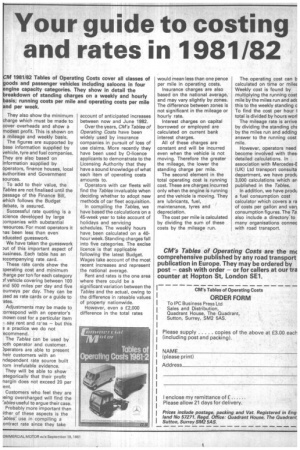Your guide to costing and rates in 1981/82
Page 37

If you've noticed an error in this article please click here to report it so we can fix it.
M 1981/82 Tables of Operating Costs cover all classes of oods and passenger vehicles including saloons in four ngine capacity categories. They show in detail the reakdown of standing charges on a weekly and hourly asis; running costs per mile and operating costs per mile nd per week.
They also show the minimum charge which must be made to cover overheads and show a modest profit. This is shown on a mileage and weekly basis.
The figures are supported by base information supplied by vehicle, tyre and fuel companies. They are also based on information supplied by operators, finance houses, local authorities and Government sources.
To add to their value, the Tables are not finalised until the passage of the Finance Bill, wvhich follows the Budget debate, is assured.
Successful rate quoting is a 3cience developed by large aompanies with substantial -esources. For most operators it las been less than even Klucated guesswork.
We have taken the guesswork Jut of this important aspect of ousiness. Each table has an accompanying rate card.
These rate cards show the )perating cost and minimum :harge per ton for each category )f vehicle covering between 100 and 500 miles per day and five ourneys per day. They can be ised as rate cards or a guide to iates.
Adjustments may be made to ;orrespond with an operator's :nown cost for a particular item say rent and ra — but this s a practice we do not ecommend.
The Tables can be used by aoth operator and customer. )perators are able to present heir customers with an ndependent rate source built mom irrefutable evidence.
They will be able to show iategoricallv that their profit nargin does not exceed 20 per ent.
Customers who feel they are leing overcharged will find the rabies useful to argue their case.
Probably more important than ither of these aspects is the "ables' use in compiling a ontract rate since they take account of anticipated increases between now and June 1982.
Over the years, CM's Tables of Operating Costs have been widely used by insurance companies in pursuit of loss of use claims. More recently they have been used by 0-licence applicants to demonstrate to the Licensing Authority that they have a sound knowledge of what each item of operating costs amounts to.
Operators with car fleets will find the Tables invaluable when deciding whether to adopt new methods of car fleet acquisition.
In compiling the Tables, we have based the calculations on a 45-week year to take account of holidays and servicing schedules. The weekly hours have been calculated on a 40hour week. Standing charges fall into five categories. The excise licence is that applicable following the latest Budget. Wages take account of the most recent increases and represent the national average.
Rent and rates is the one area where there could be a significant variation between the Tables and the actual, owing to the difference in rateable values of property nationwide.
However, even a £2,000 difference in the total rates would mean less than one pence per mile in operating costs.
Insurance charges are also based on the national average, and may vary slightly by zones. The difference between zones is not significant in the mileage or hourly rate.
Interest charges on capital borrowed or employed are calculated on current bank interest charges.
All of these charges are constant and will be incurred even when the vehicle is not moving. Therefore the greater the mileage, the lower the standing charge per mile.
The second element in the total operating cost is running cost. These are charges incurred only when the engine is running and the vehicle is moving. They are lubricants, fuel, maintenance, tyres and depreciation.
The cost per mile is calculated by dividing the sum of these costs by the mileage run. The operating cost can b calculated on time or mileE Weekly cost is found by multiplying the running cost mile by the miles run and ad( this to the weekly standing c To find the cost per hour 1 total is divided by hours wonl The mileage rate is arrive by dividing the standing dm by the miles run and adding answer to the running cost mile.
However, operators need become involved with thesi detailed calculations. In association with Mercedes-E (UK) Ltd transport consulta department, we have produ 3,000 calculations which an published in the Tables.
In addition, we have produ a fuel consumption cost calculator which covers a ra of costs per gallon and veil consumption figures. The Ta. also include a directory to many organisations connec with road transport.








































































